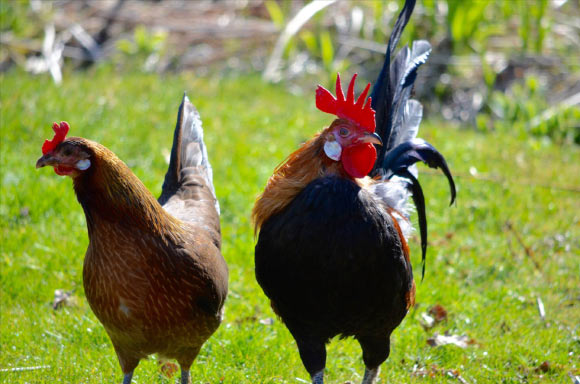The red junglefowl (Gallus gallus), a species of tropical bird found in south-east Asia, is the primary ancestor of the domestic chicken (Gallus gallus domesticus). Its domestication likely began in India and China approximately 8,000 years ago and geographically expanded along with trade to the countries of the Mediterranean region. A new study, published in the journal Royal Society Open Science, shows that when ancient humans selected the tamest red junglefowl individuals for breeding, they may at the same time have unconsciously selected birds with a different brain — one that may have been more suitable for a life among humans.
“The aim of our study was to analyze changes in total brain size as well as relative sizes of different brain regions in juvenile red junglefowl selected for diverging levels of fear of human and, secondly, to test possible differences in cognitive functions in selection lines with different brain sizes,” said Rebecca Katajamaa and Professor Per Jensen from the AVIAN Behaviour Genomics and Physiology Group at Linköping University.
“We hypothesize that selection for reduced fear of humans will lead to smaller brains and affect the performance in cognitive tasks in chicks through correlated selection responses.”
The researchers selected red junglefowl for high and low fear of humans for 10 generations. The birds used in the study were from the 9th and 10th selected generation.
“We believe that they have in this way imitated the factor that must have been the most important during early domestication, namely that it was possible to tame the animals,” they explained.
The brains of the domesticated birds gradually became smaller relative to body size, which mirrors what has happened to the chickens during the domestication process.
The change was particularly pronounced in the brain stem, a primitive part of the brain that is involved in, among other things, certain stress reactions. The brain stem was relatively smaller in animals that were not overly timid.
The scientists carried out two behavioral experiments to determine whether the difference in brain size and composition affected the ability of the fowl to learn.
One test investigated how rapidly the birds became accustomed to something that could be experienced as frightening, but which was actually non-hazardous, in this case a flashing light.
The tame birds became accustomed and stopped reacting to the stimulus significantly more rapidly.
“We believe that the ability to become accustomed rapidly is beneficial for the birds that are to live among humans, where events that are unknown and frightening, but not dangerous, are part of everyday life,” Katajamaa said.
The authors also investigated whether the birds differed in the ability to learn to associate two things with each other, such as coupling a certain pattern with food. This process is known as ‘associative learning.’
However, they found no differences between the two groups.
“Our study not only sheds light on a possible process by which chickens — and possibly other species — become domesticated,” Professor Jensen said.
“It may also give new insight into how the structure of the brain is connected with differences in behavior between individuals and species.”
_____
Rebecca Katajamaa & Per Jensen. 2020. Selection for reduced fear in red junglefowl changes brain composition and affects fear memory. R. Soc. open sci 7 (8): 200628; doi: 10.1098/rsos.200628








